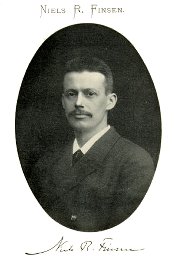Niels Ryberg Finsen
Dennis P. Valenzeno
Associate Dean for Medical Sciences
Chair and Professor of the Department of Medical Sciences
The University of Kansas Medical Center - Wichita
1010 N. Kansas St., Wichita, KS 67214-3199
dvalenzeno@kumc.edu
(Reprinted from a two-part article in the ASP Newsletter
(No. 117, Oct/Nov 1988 and No. 118, Dec/Jan 1988-9)
Of Tadpoles and Red Rooms
What do you do with a boy who is dismissed from prep school for "small ability and total lack of energy?" Of what utility to society is a man whose health begins to fail at 23 and who is almost completely incapacitated by the age of 30?......You have the makings of a Nobel Prize recipient who is generally regarded as the founder of modern phototherapy, Niels Ryberg Finsen. In his brief 44 years, Finsen employed his knowledge of light to relieve countless people from terrible disfigurement from smallpox and lupus vulgaris. All of this was accomplished despite rejection by the established research community and failing health. Finsen was relegated to a wheel chair as he accepted the 1903 Nobel Prize in physiology and medicine. His death occurred the following year.

Figure 1. Niels Ryberg Finsen. [Courtesy of the Clendening History of Medicine Library, University of Kansas Medical Center.]
A descendant of Viking Icelanders and the son of the governor of the Faeroe Islands, Finsen was educated in Reykjavik, Iceland, and subsequently obtained his M.D. at the University of Copenhagen in 1891. Though tempted by a career in surgery, he chose instead to pursue his interest in sunlight as a therapeutic force. His earliest experiments were performed with the simplest of devices. His own skin, the earlobes of his young wife, and assorted tadpoles convinced Finsen that sunlight could produce inflammation, similar to that known to be produced by microbes. This, he reasoned, could be the cause of inflammation in sun-exposed smallpox blisters. Infection and blood poisoning might be avoided if the inflammatory response to light could be prevented.
Finsen demonstrated that it was the violet end of the spectrum that produced the inflammation and that the red end had a healing effect. His exposition of this proposal to the chief physician of the Blegdam Hospital in Copenhagen was rejected with such little respect that it prompted Finsen to retort, "You might at least try not to laugh at me!" It remained for two doctors in Bergen, Norway to sequester newly diagnosed smallpox patients for two weeks in "red rooms" to validate Finsen's hypothesis. Every patient emerged with no fever, free of blood poisoning and scarless! A similar report of success from Gothenburg, Sweden gained Finsen an international reputation and launched his career and the field of phototherapy.
Electric Lights & Broken Needles
By 1894, Finsen had earned a reputation with his "red room" treatment for smallpox. Still he remained a struggling young physician with no job and no recorded means of support. But he was convinced that light could cure as well as harm. Building on the demonstrations of Duclaux, which showed that sunlight could kill bacteria, Finsen reasoned that tubercle bacilli, the bacteria responsible for the disfiguring lesions of lupus vulgaris, might succumb to sunlight. But how could the theory be tested? Where does one find sunlight in Copenhagen in winter? Again the Copenhagen medical establishment turned him away. How could light which could kill smallpox patients, cure lupus patients, they asked? Finsen persisted and arranged with the chief engineer of the electric light works for the use of a 25 amp D.C. carbon arc lamp. There, in the electric light plant, Finsen treated the lupus vulgaris of a Danish engineer named Mogensen who had been given up by countless doctors as untreatable. For two hours every day over the course of 4 months the treatment persisted. But at the end of that time, Mogensen emerged a cured man, causing an uproar in the medical community.
Finsen's fortunes changed dramatically. In 1896 the Medical Light Institute (now the Finsen Institute) was founded and placed under his direction providing him with a modest annual salary. During the next few years he refined his treatment to obtain more consistent success, but his health continued to fail. Despite a self-imposed diet of desiccated food and almost no water, he continued to accumulate fluid as a result of constrictive pericarditis. In the winter of 1902 as a physician began yet another drainage of fluid from Finsen's abdomen, there was a snap. The needle used to perforate the abdomen had broken from its handle and had slid down the trocar into Finsen's abdomen. Both Finsen and his physician knew that an operation to remove it was hopeless given Finsen's condition. Keeping his composure, Finsen directed the physician to get the strongest magnet available in the engineering college. If the end of the needle was still in the trocar, perhaps it could be removed. Thus, in the summer of 1904 Niels Finsen, a man whose intellect and composure had saved his own life, as well as the lives of countless others, sat in his wheel chair at home, and received the Nobel Prize in physiology and medicine. Later the same year, still planning whole body sun bath treatments, he died with his wife at his side.
Every 4 years the Association Internationale de Photobiology presents the Finsen Medal on behalf of the Niels Finsen Foundation of Denmark for outstanding contributions to the science of photobiology. For a list of awardees, see A CENTURY OF PHOTOBIOLOGY, Table 2 under Historical Vignettes on Photobiology.